A sea of tens of thousands of farmers riding tractors and horses stormed India’s historic Red Fort this week — a dramatic escalation of their protests, which are posing a major challenge to Prime Minister Narendra Modi's government.
The AP explains what is at the heart of two months of demonstrations and what it means for Modi's government.
WHO IS PROTESTING?
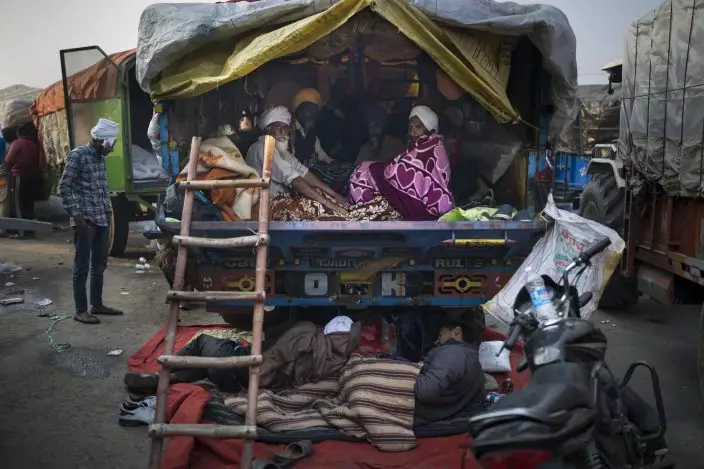
FILE - In this Tuesday, Dec. 1, 2020, file photo, Indian farmers huddle together in the back of their tractor trailer early morning as they protest against new farm laws, at the Delhi-Haryana state border, India. The protests gained momentum in November when the farmers tried to march into New Delhi but were stopped by police. Since then, they have promised to hunker down at the edge of the city until the laws are repealed. (AP PhotoAltaf Qadri, File)
Most of the protesters are farmers from northern Punjab and Haryana states, the two biggest agricultural producers. They are demanding the repeal of laws passed by Parliament in September that they say will favor large corporate farms, devastate the earnings of many farmers and leave those who hold small plots behind as big corporations win out. Modi has billed the laws as necessary to modernize Indian farming.
Because of the demographics of Punjab and Haryana, many of the protesters in New Delhi happen to be from India’s minority Sikh religion, though their grievances are rooted in economic issues, not religious ones. Protests are also happening in other parts of the country among Indians of other backgrounds.
In recent weeks, people who are not farmers have also joined in, and the protests gained momentum in November when the farmers tried to march into New Delhi but were stopped by police. Since then, they have promised to hunker down at the edge of the city until the laws are repealed.

FILE - In this Friday, Nov. 27, 2020, file photo, a protesting farmer throws back a tear gas shells past concrete road blocks set up by policemen, at the border between Delhi and Haryana state. Prime Minister Narendra Modi's government also initially tried to discredit the farmers — who happen to be largely Sikh because of the demographics of the agricultural powerhouse states — by dismissing their concerns as motivated by religious nationalism.But such allegations appear to have backfired, further angering the farmers, many of whom serve in the Indian army, police and civil service. Since then, common citizens also joined them and the protests have gathered strength. (AP PhotoAltaf Qadri, File)
WHAT ARE THEIR CONCERNS?
At the heart of these protests are Indian farmers’ fears that the government's moves to introduce market reforms to the farming sector will leave them poorer — at a time when they are already frustrated over their declining clout as the government aims to turn India into a hub for global corporations.
The new legislation is not clear on whether the government will continue to guarantee prices for certain essential crops — a system that was introduced in the 1960s to help India shore up its food reserves and prevent shortages.
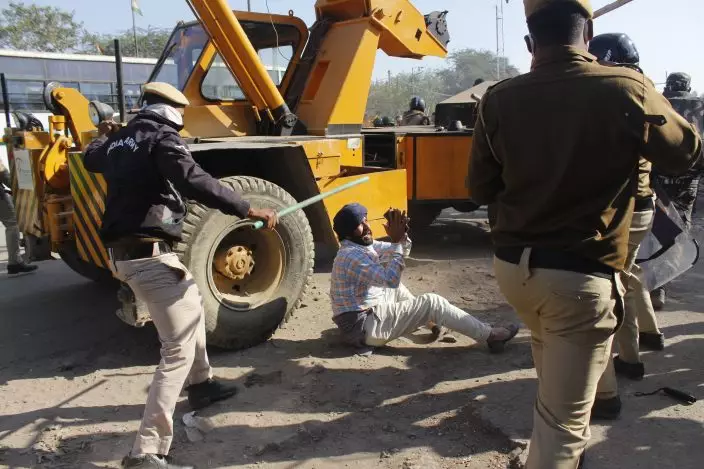
FILE - In this Friday, Nov. 27, 2020, file photo, a farmer pleads with policemen as they beat him during a protest at the border between Delhi and Haryana state. Prime Minister Narendra Modi's government also initially tried to discredit the farmers — who happen to be largely Sikh because of the demographics of the agricultural powerhouse states — by dismissing their concerns as motivated by religious nationalism.But such allegations appear to have backfired, further angering the farmers, many of whom serve in the Indian army, police and civil service. Since then, common citizens also joined them and the protests have gathered strength. (AP PhotoFile)
While the government has said it is willing to pledge the guaranteed prices will continue, the farmers are skeptical and want new legislation that says such prices are their legal right.
Farmers also fear that the legislation signals the government is moving away from a system in which an overwhelming majority of farmers sell only to government-sanctioned marketplaces. They worry this will leave them at the mercy of corporations that will have no legal obligation to pay them the guaranteed price anymore.
The government argues that this is designed to give farmers more choice in who to sell their produce to.

FILE - In this Friday, Nov. 27, 2020, file photo, protesting farmers remove a concrete barricade set up by policemen as they attempt to move towards Delhi, at the border between Delhi and Haryana state. They are demanding the repeal of laws passed by Parliament in September that they say will favor large corporate farms, devastate the earnings of many farmers and leave those who hold small plots behind as big corporations win out. (AP PhotoAltaf Qadri, File)
Clauses in the legislation also prevent farmers from taking contract disputes to courts, leaving them with no independent means of redress apart from government-appointed bureaucrats.
WHY ARE THESE PROTESTS SIGNIFICANT?
Farmers form the most influential voting bloc in India — and are often romanticized as the heart and soul of the nation.
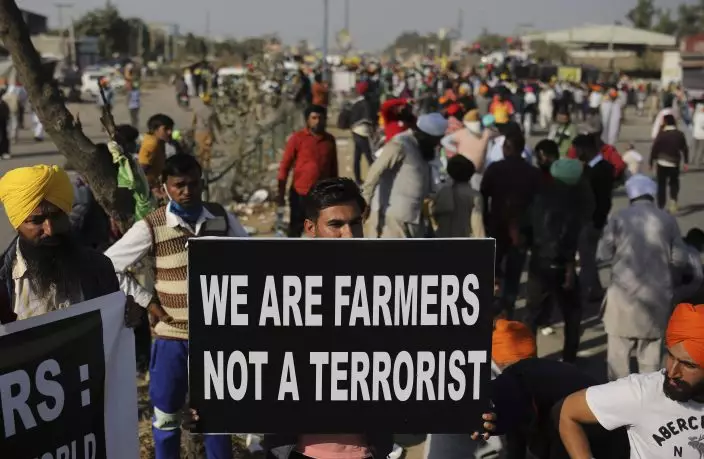
FILE - In this Saturday, Nov. 28, 2020, file photo, a farmer holds a placard on a major highway, blocking traffic as they protest new farm laws, at the Delhi-Haryana state border, India. Farmers form the most influential voting bloc in India — and have long been romanticized as the heart and soul of the nation. Even though agriculture supports more than half of the country’s 1.4 billion people, the economic clout of farmers has diminished over the last three decades. (AP PhotoAltaf Qadri, File)
Politicians have long considered it unwise to alienate them, and farmers are also particularly important to Modi’s base. Northern Haryana and few other states with substantial farmer populations are ruled by his party.
Since the legislation was passed, Modi’s government has lost two political alliance partners and some of his own leaders are cautioning him to tread carefully.
The protests against the Modi government are the biggest since he first came to power in 2014. They come at a time when the country’s economy has tanked, social strife has widened, protests have erupted against laws some deem discriminatory and the government has been questioned over its response to the coronavirus pandemic.
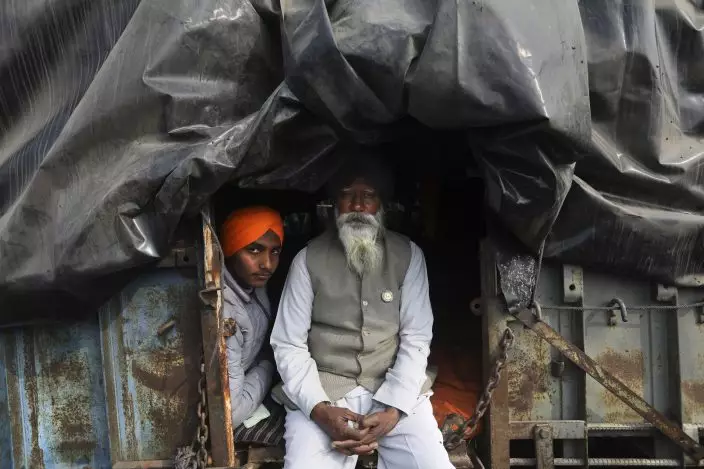
FILE - In this Friday, Jan. 1, 2021, file photo, an elderly farmer sits with his grandson in the back of their tractor trailer as they join a protest blocking a highway at the Delhi- Haryana border at the outskirts of New Delhi, India. Most of the protesters are farmers from northern Punjab and Haryana states, the two biggest agricultural producers. Farmers form the most influential voting bloc in India — and are often romanticized as the heart and soul of the nation. (AP PhotoManish Swarup, File)
WHAT IS THE GOVERNMENT SAYING?
The Modi government says the legislation will benefit farmers by boosting production through private investment.
The government has offered to amend the laws and suspend their implementation for 18 months — but that has not satisfied farmers who want a full repeal.
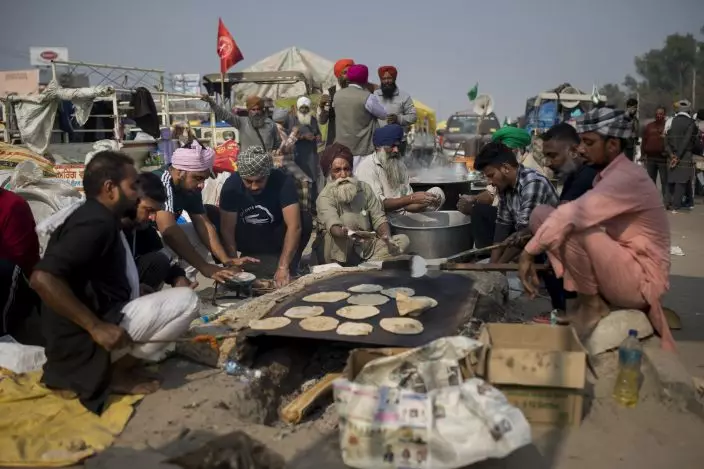
FILE - In this Tuesday, Dec. 1, 2020, file photo, protesting farmers prepare flat bread for fellow farmers as they block a major highway protesting against new farm laws, at the Delhi-Haryana state border, India. Most of the protesters are farmers from northern Punjab and Haryana states, the two biggest agricultural producers. Farmers form the most influential voting bloc in India — and are often romanticized as the heart and soul of the nation. (AP PhotoAltaf Qadri, File)
Modi's government also initially tried to discredit the Sikh farmers by dismissing their concerns as motivated by religious nationalism. Some leaders in Modi's party called them “Khalistanis,” a reference to a movement for an independent Sikh homeland called “Khalistan” in the late 1980s and early 1990s.
Under Modi, India has seen a rising tide of Hindu nationalism that has rankled minority groups, mostly Muslims. Some leaders from Modi’s party and India’s freewheeling TV channels, which have long favored government’s Hindu nationalistic policies, have called the farmers “anti-national,” a label often given to those who criticize Modi or his policies.
But such allegations appear to have backfired, further angering the farmers, many of whose family members serve in the Indian army, police and civil service. Since then, common citizens also joined them, and the protests have gathered strength.
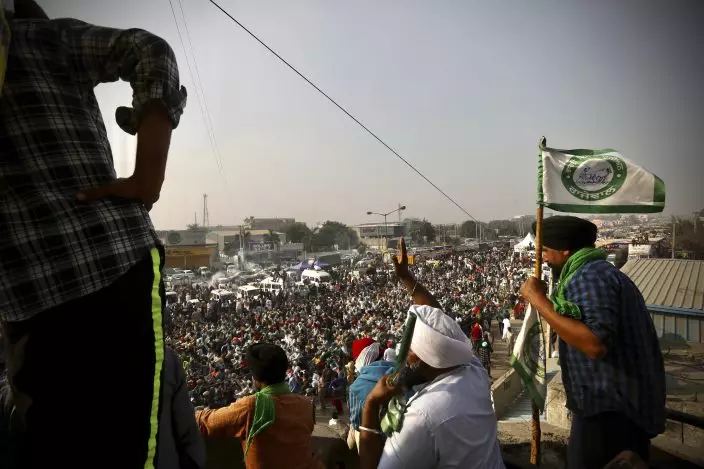
FILE - In this Thursday, Dec. 3, 2020, file photo, farmers raise slogans during a protest against new farm laws on a highway at the Delhi-Haryana state border, India. The protests against the Modi government are the biggest since he first came to power in 2014. They come at a time when the country’s economy has tanked, social strife has widened, protests have erupted against laws some deem discriminatory and the government has been questioned over its response to the coronavirus pandemic. (AP PhotoManish Swarup, File)
WHAT DOES IT MEAN FOR MODI?
While this is a major challenge to his government, Modi’s popularity is still soaring and his approval ratings remain high because of his Hindu-nationalist policies.
Many agriculture experts agree that the Indian farming sector needs reforms, but they question the way the Modi government introduced the laws and the corporate involvement in agriculture.

FILE - In this Sunday, Dec. 27, 2020, file photo, farmers sit in the back of a trailer as they participate in a protest against new farm laws at the Delhi-Haryana state border, on the outskirts of New Delhi, India. Farmers form the most influential voting bloc in India — and are often romanticized as the heart and soul of the nation. The protests against the Modi government are the biggest since he first came to power in 2014. (AP PhotoManish Swarup, File)
“Leaving farmers to the mercy of the markets would be like a death sentence to them,” said Devinder Sharma, an agriculture expert who has spent the last two decades campaigning for income equality for Indian farmers. "We are talking about people who feed us."
Critics also highlight what they see as the Modi government’s tendency to push through reforms without building consensus. When the laws were passed in Parliament, Modi’s party refused to extend the debate over it despite repeated requests from the opposition. It also denied referring the laws to a special committee, where members could further discuss them.
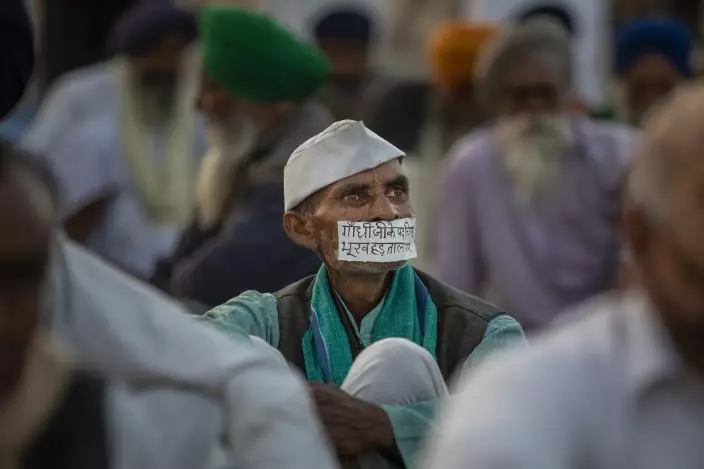
FILE - In this Wednesday, Dec. 9, 2020, file photo, a farmer sits with a tape across his mouth that reads, "Walking in the footsteps of Gandhi, I am on a hunger strike", as farmers protesting against new farm laws block a major highway at the Delhi-Uttar Pradesh state border, India. They are demanding the repeal of laws passed by Parliament in September that they say will favor large corporate farms, devastate the earnings of many farmers and leave those who hold small plots behind as big corporations win out. Modi has billed the laws as necessary to modernize Indian farming. (AP PhotoAltaf Qadri, File)
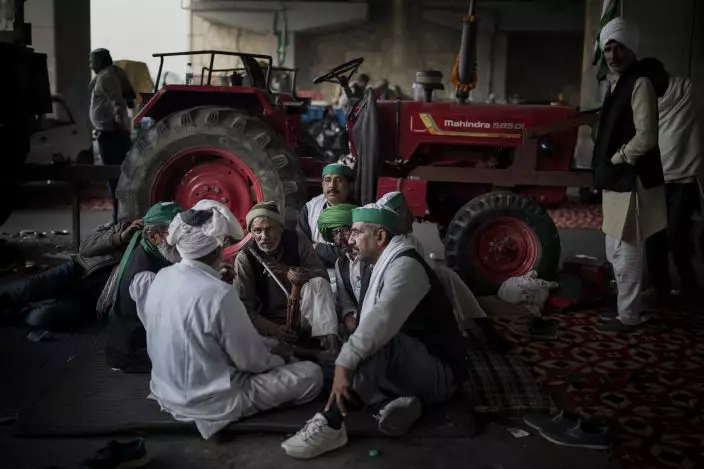
FILE - In this Saturday, Dec. 5, 2020, file photo, farmers huddle together as they share a hookah while blocking a major highway during a protest against new farm laws at the Delhi-Uttar Pradesh state border, India. The protests gained momentum in November when the farmers tried to march into New Delhi but were stopped by police. Since then, they have promised to hunker down at the edge of the city until the laws are repealed. (AP PhotoAltaf Qadri, File)
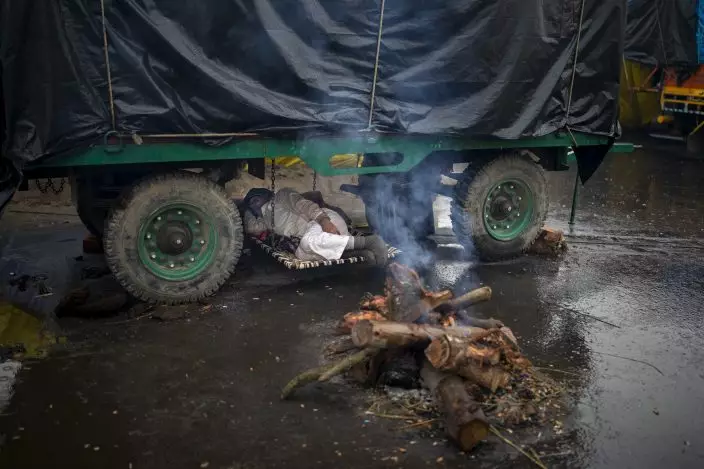
FILE - In this Monday, Jan. 4, 2021, file photo, a farmer lies under the belly of a tractor trolley next to a bonfire as they block a major highway in protest against new farm laws while it rains at the Delhi-Uttar Pradesh state border, India. The protests gained momentum in November when the farmers tried to march into New Delhi but were stopped by police. Since then, they have promised to hunker down at the edge of the city until the laws are repealed. (AP PhotoAltaf Qadri, File)
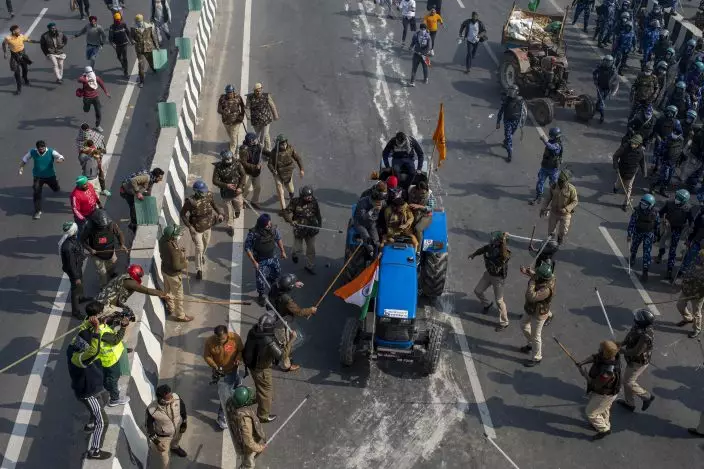
FILE - In this Tuesday, Jan.26, 2021, file photo, Indian policemen beat farmers driving a tractor towards the heart of the city as a sign of protest against new farm laws, during India's Republic Day celebrations in New Delhi, India. A sea of tens of thousands of farmers riding tractors and horses stormed India’s historic Red Fort this week, a dramatic escalation of their protests, which are posing a major challenge to Prime Minister Narendra Modi’s government. (AP PhotoAltaf Qadri, File)
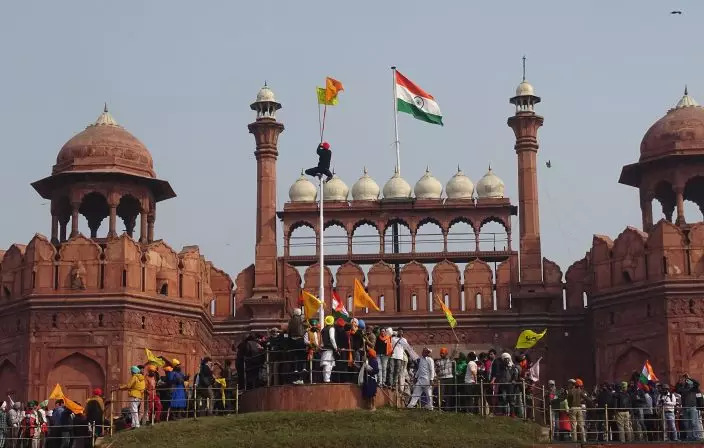
FILE - In this Tuesday, Jan. 26, 2021, file photo, a Sikh man hangs on to pole holding a Sikh religious flag along with a farm union flag at the historic Red Fort monument during a farmers protest against new farm laws in New Delhi, India. A sea of tens of thousands of farmers riding tractors and horses stormed India’s historic Red Fort this week — a dramatic escalation of their protests, which are posing a major challenge to Prime Minister Narendra Modi’s government. (AP PhotoDinesh Joshi, File)
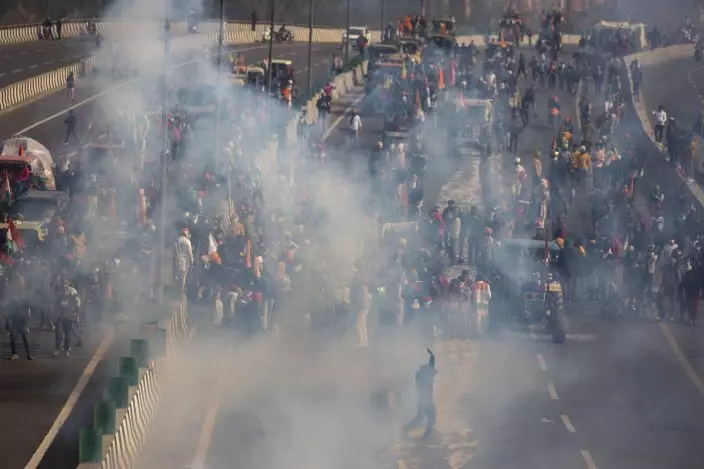
FILE - In this Tuesday, Jan. 26, 2021, file photo, protesting farmers are seen amid tear gas smoke fired by police in an attempt to stop them from marching to the capital during India's Republic Day celebrations in New Delhi, India. A sea of tens of thousands of farmers riding tractors and horses stormed India’s historic Red Fort this week, a dramatic escalation of their protests, which are posing a major challenge to Prime Minister Narendra Modi’s government. (AP PhotoAltaf Qadri, File)


